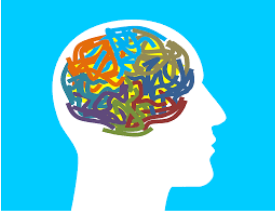Mental Health During a Pandemic: Getting Help, Detecting it in Your Friends, etc.
Disclaimer: Please do not attempt to self-diagnose yourself with the symptoms provided in this article. Despite the time spent on researching and finding reliable sources for each of these mental illnesses, I am not a professional and when you find the time is right, you should only have a professional treat and diagnose you. Resources to do so will be provided at the end of this article.

Mental health is an issue that occurs throughout the entire year across all ages and genders. However, it has become immensely important to draw emphasis to mental health awareness during a global pandemic.
If a pandemic wasn’t bad enough, the world, especially America, has witnessed an unprecedented mental health crisis across types of mental illnesses. Two of the most prominent mental health issues, anxiety, and depression, are commonly talked about during all time periods, especially now. However, there are more mental health issues than common issues, including borderline personality disorder, bipolar disorder, schizophrenia, and dissociative identity disorder. In America, 1.6% of the population has BPD (verywellmind.com), 2.6% of adults in America have bipolar depression (dbsalliance.org), about 0.25%-0.64% of Americans have schizophrenia (NIMH.nih.gov), and 0.5%-2% of the population have dissociative identity disorder (therecoveryvillage.com). Although these issues aren’t as common as anxiety and depression, they are still mental illnesses that occur in our population, including teenagers.
Those who have borderline personality disorder experience “an ongoing pattern of varying moods, self-image, and behavior…intense episodes of anger, depression, and anxiety that can last from a few hours to days,” according to the National Institute of Mental Health. As a result of varying moods, those who have borderline personality disorder also have changing interests. In addition to this, people with BPD tend to “view things in extremes” (NIMH) which typically causes very high or very low moods and unstable relationships with others. Although these are the most common symptoms, other symptoms may include fear of abandonment, distorted sense of self, impulsive behaviors and decision making, self-harming, suicidal thoughts, and feelings of emptiness.
Bipolar disorder, also termed manic depression, is a mental illness that includes symptoms of extremely high and low mood swings, and severe alterations in sleep, energy, motivation, and behavior. The symptom that mainly classifies this disorder as bipolar are the extreme highs and lows with mood. According to webmd.com, “In between those periods, they usually feel normal. You can think of the highs and the lows as two ‘poles’ of mood, which is why it’s called ‘bipolar’ disorder.” Furthermore, people who have bipolar disorder also experience mania, which can cause impulsive decision making and feelings of overconfidence and recklessness. Although all bipolar disorders are categorized by severe mood swings, and periods of highs and lows, there are three types of bipolar disorders that are different in the extremeness of these periods. First, Bipolar I disorder is the most extreme out of the three–it is categorized by erratic behavior, long periods of mania, and extreme “down” periods. In comparison, Bipolar II disorder includes erratic behaviors and impulsiveness, but it isn’t as severe as Bipolar I. The last type, cyclothymic disorder, is less intense periods of manic and depressive behavior that “lasts at least two years in adults or one year in children and teens,” according to webmd.com.
To continue, another mental illness that is commonly talked about is schizophrenia, which is a mental illness characterized by hallucinations and delusions. This disorder is more easily diagnosable compared to BPD and bipolar depression due to the fact that its symptoms are easier to recognize. However, there are a vast amount of delusions and hallucinations that a person may experience depending on that specific person and their environment. One of the most common delusions that people who have schizophrenia experience is the feeling of being watched or that people are plotting against you. Besides delusions and hallucinations, those who have schizophrenia also experience disorganized thoughts and feelings, abnormal motor behavior, and a lack of emotion (mayoclinic.org). Although schizophrenia can be difficult to diagnose as a teenager, some of the symptoms that are recognizable at the ages of 13-18 include “withdrawal from family and friends, a drop in performance at school, trouble sleeping, irritability or depressed mood, and lack of motivation” according to the MayoClinic.
One of the most complex mental illnesses and one of the least common mental illnesses is dissociative identity disorder (multiple personality disorder) which includes symptoms of severe dissociation, and “a lack of connection in a person’s thoughts, memories, feelings, actions, or sense of identity”, according to webmd.com. Webmd.com also explains that “The dissociative aspect is thought to be a coping mechanism — the person literally shuts off or dissociates themselves from a situation or experience that’s too violent, traumatic, or painful to assimilate with their conscious self.” If you are unaware of what dissociation means, it is similar to “daydreaming” or “zoning out,” but it is much more extreme and feels like a disconnect between your mind and body. People who have DID typically dissociate due to trauma or uncomfortable circumstances that impacted their mental state.
For the most part, these mental illnesses include similar behaviors and symptoms. However, each of these has different methods of diagnosis and particular ways of treatment. BPD is typically diagnosed by a licensed mental health professional through a thorough interview, a careful medical exam, and an examination of family medical history. Once this is finished, people who have BPD can get treatment by “newer, evidence-based treatment” (NIMH) which can help a person experience fewer symptoms.
Similar to BPD, those who have bipolar disorder will need to go through a psychiatric evaluation in order to get a proper diagnosis. Once this is completed, they can get treated with medication (mood stabilizers, antidepressants, etc.), psychotherapy, electroconvulsive therapy, acupuncture, and/or supplements. Besides this, lifestyle changes like a better sleep schedule and keeping a journal can help lessen the mood swings.
In order to determine a diagnosis of someone who has schizophrenia, the person will have to get a physical exam, various screening tests, and a psychiatric evaluation. Once this is completed and they’ve received a proper diagnosis, they can go through various treatments such as medication, different types of therapy, and, if needed, hospitalization.
Lastly, webmd.com has identified DID as one of the most difficult disorders to diagnose since the diagnosis can take weeks to years for an accurate diagnosis. This is mainly due to the fact that those who have DID may also have anxiety, depression, and/or PTSD. According to the DSM-5, the following criteria can be used to diagnose DID:
- Two or more distinct identities or personality states are present, each with its own relatively enduring pattern of perceiving, relating to, and thinking about the environment and self.
- Amnesia must occur, defined as gaps in the recall of everyday events, important personal information, and/or traumatic events.
- The person must be distressed by the disorder or have trouble functioning in one or more major life areas because of the disorder.
- The disturbance is not part of normal cultural or religious practices
- symptoms cannot be due to the direct physiological effects of a substance (such as blackouts or chaotic behavior during alcohol intoxication) or a general medical condition (such as complex partial seizures).
Once a proper diagnosis has been made, medical professions will prescribe the following treatment for people who have DID: psychotherapy, hypnotherapy, and adjunctive therapy.
In general, not only have people who have mental illness have had to cope with their illnesses during a pandemic but those who don’t are more susceptible to potentially experience symptoms of mental illness or seeking a diagnosis for a mental illness. The pandemic is an extremely stressful and anxious period of time, but the best thing everyone can do is be there for their friends and family and find healthy ways to cope, whether it be by calling friends, exercising, eating healthier, journaling, meditating, or focusing on yourself. Although you may feel that therapy is too difficult to find during this unprecedented period of time, there are much online therapy and socially-distance in-person therapy options.
Hotlines:
- National Suicide Prevention Lifeline: 1-800-273-TALK (8255)
- The deaf and hard of hearing can contact the Lifeline via TTY at 1-800-799-4889
- Disaster Distress Hotline: 1-800-985-5990 or text “TalkwithUs” to 66746
- Crisis Text Line: text HELLO to 741741
- Dating Abuse and Domestic Violence: 1-866-331-9474
- The Trevor Project (LGBTQ community): 866-488-7386
- Eating Disorder Hotline: 1-800-931-2237
- Mental Illness Hotline: 1-800-950-6264
- Sexual Assault Hotline: 1-800-656-4673
Seeking Help:
- Talk to your parents and ask about seeing a therapist and getting properly diagnosed
- Speak to a guidance counselor or the school psychologist
- Use a national hotline for 24/7 help
- Talk to your teachers and ask for guidance
- Ask friends who have received help for advice
Your donation will support the student journalists of Parkland High School. Your contribution will allow us to purchase equipment and cover our annual website hosting and printing costs.







